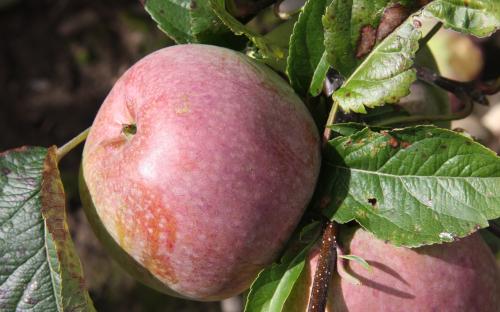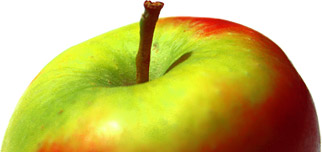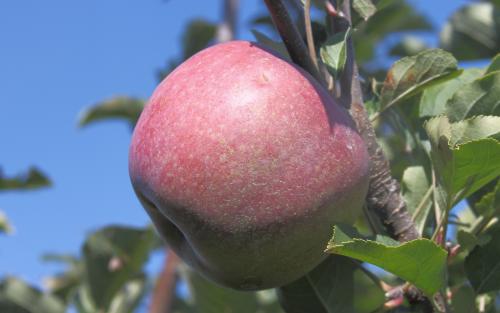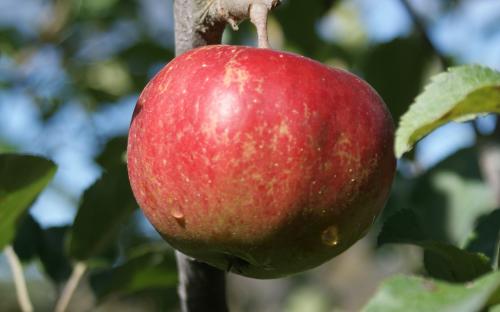
An heirloom American apple variety, commonly found in New York state. Named for the blue-colored bloom.
Blue Pearmain apple identification images
All images copyright Orange Pippin unless otherwise stated.
USDA identification images for Blue Pearmain
The identification paintings in the USDA Pomological Watercolor Collection span the years 1886 to 1942.
Citation: U.S. Department of Agriculture Pomological Watercolor Collection. Rare and Special Collections, National Agricultural Library, Beltsville, MD 20705.
Visitor reviews
- 16 Nov 2024Beautiful big dark mottled apple, keeps well, solid flesh, does not have a strong flavor
- 06 Nov 2018 QUEBEC, CanadaI've crossed this heirloom apple at an orchard store this fall, so I decided to buy a 5 lbs bag. These are huge apples with a very dense flesh. Very filling, not the kind of apple to wake a hunger. I find this apple has a nice pear taste with just enough acidity to taste it properly. Not a juicy apple, but quite moist. The last ones I have feel rubbery when I press them. Good apple but only a "3" note.
- 22 Oct 2016 MAINE, United StatesI have just grafted 5 blue pearmain trees for my orchard in Maine
- 15 Oct 2016 NM, United Statescomplex flavor, dense yellowish flesh, aromatic, sweet, a heavy producer. Very large apples with a purplish/blue blush.
- 09 Oct 2016 NORFOLK, United Kingdom40 years ago I moved house. There was one old apple tree in the garden, that had been grafted with 2 different varieties (a 'family tree' I think the Victorians called them). One was not very interesting - a Codlin I think. The other, after many years of trying to identify, I decided was a Blue Pearmain. It was large, with a wonderful taste, and it kept well. Looked like the photos here. Since moving, I've had a lot of trouble finding another - finally planted a young tree 2 years ago. It hasn't fruited yet ... in anticipation!
- 16 Oct 2015 MA, United StatesI just found an abandoned Blue Pearmain tree at the beginning of my road in an old field. I have been driving by it now for 29 years and never noticed the red apples on it. I stopped and collected a few. I crunched into one and thought: "This is a really nice apple. I wonder what it is?" It was sweet and crunchy then came a zing of tartness. It had a conical shape similar to a Red Delicious but way beyond the flavor of a red delicious ( a misnomer if there ever was one). There used to be a lot of orchards here in central Massachusetts and I have found other abandoned tress also. I am taking it upon myself to prune this tree. I will also take scions and even try to graft a new tree for my orchard. It is a very striking looking apple. It is a deep red-purple with yellow specks and smells great. The tree must be very disease tolerant as it is healthy and has not one whit of care for the last 29 years and probably longer than that. I am very excited about finding this heirloom tree.
- 24 May 2015 OREGON, United States"Are those apples really blue?" people would ask when first seeing my Blue Pearmain tree. Of course, the only answer is "yes". Beyond that, Blue Pearmain is a sweet apple with aromatic overtones, little acid, very fine-grained flesh, a little crunch but no snap, and overall, a wonderful apple to eat out of hand. This small tree is healthy on dwarfing rootstock, not demanding, and regularly productive, though not a heavy producer. This should be the ideal backyard tree on a good dwarfing rootstock.
- 11 Mar 2014 INDIANA, United StatesThis apple has a complex flavor that would be unforgettable if it weren't so amazingly mind-blowing.
- 12 Oct 2011 NY, United Statesgreat for sauce and juice and just to eat.
- 16 Sep 2011 MASSACHUSETTS/PLYMOUTH, United StatesThe waxy skin yields an ivory, medium textured, juicy flesh with a sweet and acid balance and a tartness that lingers. The apple makes a fine cider and keeps well in cold storage.
- 01 Jan 2010 United KingdomStarter post
Tree register
United States
- Alison Gardner in Albion, CALIFORNIA
- Axel Kratel in Santa Cruz, CALIFORNIA
- Barbara Burrill in Seattle, WA / KING
- Darren Peters in Rock Spring, GEORGIA
- David Black in Bentonville, ARKANSAS
- Don Mcivor in Twisp, WA
- Earl Tuson in Loudon, NH
- Fred Lilienkamp in Hubbardston, MA
- Gina Colver in EPHRATA, WASHINGTON
- Herdie Baisden in Stockholm, WI
- Herdie Baisden in STOCKHOLM, WI
- J R Makar in Parker, CO
- Jeannie Berg in Scio, OR
- Joel Howie in Canton, NEW YORK
- John Betz in Vineland, NEW JERSEY
- John Horrell in Petaluma, CALIFORNIA
- Jon Shannon in Shaw Island, WA
- Michelle Smith in Skye Glen, NOVA SCOTIA
- Mike Haller in SIOUX CITY, IOWA
- Milovan Popovic in Ellington, CONNECTICUT
- Nathan Parker in Mount Shasta, CA
- Pat Conlin in SHELBURNE FALLS, MA
- Paul Hammen in BONDUEL, WISCONSIN
- Peter in Croom, PRINCE GEORGE'S CTY., MARYLAND
- Rick Simoniello in Storrs / Mansfield, CT
- Shirley Morelli in Northport, WA
- Stephan Orchard in Westfield, INDIANA
- Steven Stanley in Johnson City, TN
- Thomas Griffith in Cottage Grove, WI
- Tom Scampoli in NORTH PROVIDENCE, RHODE ISLAND
- Trevor Roth in Erhard, MINNESOTA
- Whitney Peters in Sixes, OREGON
United Kingdom
- Anne Rix in Swaffham, NORFOLK
- John Adams in Alvechurch, WEST MIDLANDS
- stanwatt2008@hotmail.co.uk in Gardenstown, ABERDEENSHIRE
Netherlands
- Cheuk A Lam in Amsterdam, NOORD-HOLLAND
Canada
- Erik Nordenson in Cobourg, ONTARIO
Australia
- Neville in Tea Tree Gully, SA
Spring blossom records for this variety
2017 season
- 16th October 2017 - tree owned by Neville in Tea Tree Gully, Australia
2016 season
- 2nd November 2016 - tree owned by Neville in Tea Tree Gully, Australia
2013 season
- 21st April 2013 - tree owned by Barbara in Seattle, United States
2012 season
- 21st April 2012 - tree owned by Barbara in Seattle, United States
2011 season
- 26th April 2011 - tree owned by Barbara in Seattle, United States
Record your blossom dates in our Fruit Tree Register - more >>.
Harvest records for this variety
Origins
- Species: Malus domestica - Apple
- Originates from: United States
- Introduced: 19th century
- UK National Fruit Collection accession: 1957-210
Identification
- Country of origin: United States
- Period of origin: 1800 - 1849
- Fruit colour: Red - dark
- Annual cycle: Deciduous
- Flowering duration: Average (2-3 weeks)
- Flesh colour: Cream
- Fruit size: Average
- Fruit size: Variable
Using
- Picking season: Late
- Keeping (of fruit): 3 months or more
- Flavour quality: Good
- Flavour style (apples): Sweet/Sharp
- Cropping: Good
- Food uses: Eating fresh
- Picking month: October
- Wildlife: RHS Plants for Pollinators
Growing
- Flowering group: 3
- Pollinating others: Average
- Ploidy: Diploid
- Vigour: Average vigour
- Self-fertility: Not self-fertile
Climate
- Cold hardiness (USDA): Zone 3 (-40C)
- Summer average maximum temperatures: Cool ( 20-24C / 68-75F)
- Summer average maximum temperatures: Warm (25-30C / 76-85F)
Other qualities
- Disease resistance: Good
Where to buy trees
The following tree nurseries offer Blue Pearmain apple trees for sale:
- Orange Pippin Fruit Trees (USA) United States
Blue Pearmain apple trees
Where to buy fresh fruit
The following orchards grow Blue Pearmain:
United States
California
- Arroyo Community Garden, Petaluma
Idaho
- BYU-Idaho Apple Orchard Museum, Rexburg
Maine
- McDougal Orchards, Springvale
- Sweetser's Apple Barrel and Orchards, Cumberland Center
- Tiny Orchards, Saco
New Hampshire
- Alyson's Apple Orchard, Walpole
- Gould Hill Farm, Contoocook
New York
- Black Diamond Farm, Trumansburg
Washington
- Skipley Farm, Snohomish *** Feature Orchard ***
Wisconsin
- Door Creek Orchard, Cottage Grove
Australia
Victoria
- Heritage Fruits Society, Fairfield
References
- Apples of England (1948)
Author: Taylor - Some Antique Apples for Modern Orchards, (2008)
Author: Merwin I.A.



